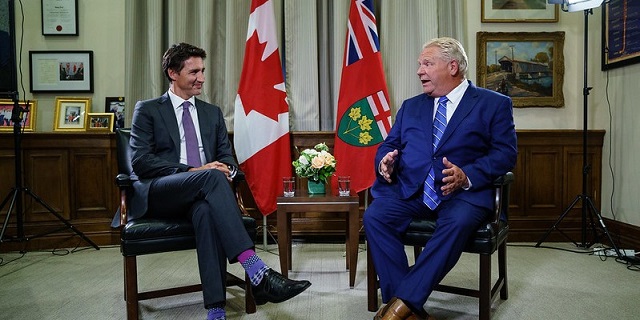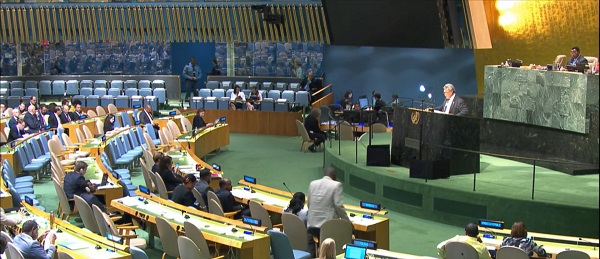Economy
The Good, the Bad and the Ugly—government budgets in 2024

From the Fraser Institute
By Grady Munro and Jake Fuss
Research showed the federal government could balance its budget in two years by slowing spending growth, yet instead the government doubled down and increased spending well past its previous estimates (against the wishes of Canadians)
This fiscal year, most provinces (and the federal government) demonstrated irresponsible fiscal management, although some were better than others. Therefore, in the words of the 1966 film starring Clint Eastwood, let’s discuss The Good, the Bad and the Ugly of Canadian government budgets in 2024.
Falling in the “good” category are Alberta and New Brunswick—the only two provinces planning to run a balanced budget in 2024/25, with Alberta forecasting a $367 million surplus and New Brunswick forecasting a $41 million surplus. Both provinces forecast surpluses until at least 2026/27, and expect net debt (total debt minus financial assets) as a share of the economy to decline in the years to come. However, what keeps these provinces from having a great budget is that both chose to further increase spending in the face of higher revenues, while failing to deliver much-needed tax relief.
Alberta in particular remains at risk of seeing future surpluses disappear, as the province relies on historically high resource revenues to fund its high spending. Should these volatile revenues decline, the province would return to operating at a deficit and growing its debt burden.
Provinces in the “bad” category include, but aren’t limited to, Saskatchewan and Newfoundland and Labrador. Largely due to quick growth in program spending that wipes out any revenue gains, both provinces expect deficits in 2023/24 and 2024/25 before planning to balance their budgets in 2025/26. The risks of unchecked spending growth are most salient in Saskatchewan, where just one year ago the province projected surpluses in both 2023/24 and 2024/25. And resulting from many years of deficits and debt accumulation, debt interest costs in Newfoundland and Labrador are expected to reach $2,123 per person in 2024/25, the highest in Canada.
Key governments among the “ugly” are the federal government, Ontario and British Columbia. Let’s take them one by one.
The federal government delivered a budget that continues the same failed approach that’s produced nearly a decade of stagnation in Canadian living standards. The Trudeau government plans to run a $39.8 billion deficit in 2024/25, followed by deficits of $20.0 billion or higher until at least 2028/29. Prior to the budget, research showed the federal government could balance its budget in two years by slowing spending growth, yet instead the government doubled down and increased spending well past its previous estimates (against the wishes of Canadians).
In addition to continuous spending increases and debt accumulation, the Trudeau government increased capital gains taxes on all businesses and many Canadians. Presented as a way to make the tax system more “fair” while generating $20 billion in revenue, in reality it is a harmful tax increase that is unlikely to generate the planned amount of revenues while simultaneously hindering economic growth and prosperity.
Similar to the federal government, in its 2024 budget Ontario’s Ford government simply doubled down on the same approach it’s taken in previous years. This “stay the course” fiscal plan added an average of $3.8 billion in new annual program spending (compared to last year’s budget) over the three years from 2023/24 to 2025/26. This new spending delays the province’s expected return to surpluses until 2026/27, and rather than run a $200 million surplus in 2024/25 the Ford government now plans to run a $9.8 billion deficit.
Importantly, the Ford government failed to deliver any meaningful tax relief for Ontarians in this budget, which once again breaks its promise to reduce personal income tax rates. Given that Ontarians face some of the highest personal income tax rates in North America, relief would help keep money in people’s pockets while also promoting economic growth.
Finally, the Eby government in B.C. tabled a budget that can be best described as a generational error in terms of the planned debt accumulation. The government plans to run a $7.9 billion deficit in 2024/25, followed by deficits of $7.8 billion and $6.4 billion in 2025/26 and 2026/27, respectively. In other words, the Eby government plans to run deficits in the coming years that are nearly as large or larger than those expected in Ontario, despite B.C. having a little over one-third of Ontario’s population.
Runaway spending drives these deficits and will contribute to a $55.1 billion (74.7 per cent) increase in provincial net debt from 2023/24 to 2026/27. This massive runup in debt will result in higher debt interest costs, which leaves less money available for services such as healthcare and education, or pro-growth tax relief for British Columbians.
By and large, governments across Canada demonstrated an irresponsible approach to managing public finances in this year’s round of budgets. While there were a couple of bright spots, the majority of provinces instead chose to increase spending, grow deficits and debt, and introduce little to no meaningful tax relief.
Authors:
Business
Most Canadians say retaliatory tariffs on American goods contribute to raising the price of essential goods at home

- 77 per cent say Canada’s tariffs on U.S. products increase the price of consumer goods
- 72 per cent say that their current tax bill hurts their standard of living
A new MEI-Ipsos poll published this morning reveals a clear disconnect between Ottawa’s high-tax, high-spending approach and Canadians’ level of satisfaction.
“Canadians are not on board with Ottawa’s fiscal path,” says Samantha Dagres, communications manager at the MEI. “From housing to trade policy, Canadians feel they’re being squeezed by a government that is increasingly an impediment to their standard of living.”
More than half of Canadians (54 per cent) say Ottawa is spending too much, while only six per cent think it is spending too little.
A majority (54 per cent) also do not believe federal dollars are being effectively allocated to address Canada’s most important issues, and a similar proportion (55 per cent) are dissatisfied with the transparency and accountability in the government’s spending practices.
As for their own tax bills, Canadians are equally skeptical. Two-thirds (67 per cent) say they pay too much income tax, and about half say they do not receive good value in return.
Provincial governments fared even worse. A majority of Canadians say they receive poor value for the taxes they pay provincially. In Quebec, nearly two-thirds (64 per cent) of respondents say they are not getting their money’s worth from the provincial government.
Not coincidentally, Quebecers face the highest marginal tax rates in North America.
On the question of Canada’s response to the U.S. trade dispute, nearly eight in 10 Canadians (77 per cent) agree that Ottawa’s retaliatory tariffs on American products are driving up the cost of everyday goods.
“Canadians understand that tariffs are just another form of taxation, and that they are the ones footing the bill for any political posturing,” adds Ms. Dagres. “Ottawa should favour unilateral tariff reduction and increased trade with other nations, as opposed to retaliatory tariffs that heap more costs onto Canadian consumers and businesses.”
On the issue of housing, 74 per cent of respondents believe that taxes on new construction contribute directly to unaffordability.
All of this dissatisfaction culminates in 72 per cent of Canadians saying their overall tax burden is reducing their standard of living.
“Taxpayers are not just ATMs for government – and if they are going to pay such exorbitant taxes, you’d think the least they could expect is good service in return,” says Ms. Dagres. “Canadians are increasingly distrustful of a government that believes every problem can be solved with higher taxes.”
A sample of 1,020 Canadians 18 years of age and older was polled between June 17 and 23, 2025. The results are accurate to within ± 3.8 percentage points, 19 times out of 20.
The results of the MEI-Ipsos poll are available here.
* * *
The MEI is an independent public policy think tank with offices in Montreal, Ottawa, and Calgary. Through its publications, media appearances, and advisory services to policymakers, the MEI stimulates public policy debate and reforms based on sound economics and entrepreneurship.
Business
Trump confirms 35% tariff on Canada, warns more could come

Quick Hit:
President Trump on Thursday confirmed a sweeping new 35% tariff on Canadian imports starting August 1, citing Canada’s failure to curb fentanyl trafficking and retaliatory trade actions.
Key Details:
- In a letter to Canadian Prime Minister Mark Carney, Trump said the new 35% levy is in response to Canada’s “financial retaliation” and its inability to stop fentanyl from reaching the U.S.
- Trump emphasized that Canadian businesses that relocate manufacturing to the U.S. will be exempt and promised expedited approvals for such moves.
- The administration has already notified 23 countries of impending tariffs following the expiration of a 90-day negotiation window under Trump’s “Liberation Day” trade policy.
Diving Deeper:
President Trump escalated his tariff strategy on Thursday, formally announcing a 35% duty on all Canadian imports effective August 1. The move follows what Trump described as a breakdown in trade cooperation and a failure by Canada to address its role in the U.S. fentanyl crisis.
“It is a Great Honor for me to send you this letter in that it demonstrates the strength and commitment of our Trading Relationship,” Trump wrote to Prime Minister Mark Carney. He added that the tariff response comes after Canada “financially retaliated” against the U.S. rather than working to resolve the flow of fentanyl across the northern border.
Trump’s letter made clear the tariff will apply broadly, separate from any existing sector-specific levies, and included a warning that “goods transshipped to evade this higher Tariff will be subject to that higher Tariff.” The president also hinted that further retaliation from Canada could push rates even higher.
However, Trump left the door open for possible revisions. “If Canada works with me to stop the flow of Fentanyl, we will, perhaps, consider an adjustment to this letter,” he said, adding that tariffs “may be modified, upward or downward, depending on our relationship.”
Canadian companies that move operations to the U.S. would be exempt, Trump said, noting his administration “will do everything possible to get approvals quickly, professionally, and routinely — In other words, in a matter of weeks.”
The U.S. traded over $762 billion in goods with Canada in 2024, with a trade deficit of $63.3 billion, a figure Trump called a “major threat” to both the economy and national security.
Speaking with NBC News on Thursday, Trump suggested even broader tariff hikes are coming, floating the idea of a 15% or 20% blanket rate on all imports. “We’re just going to say all of the remaining countries are going to pay,” he told Meet the Press moderator Kristen Welker, adding that “the tariffs have been very well-received” and noting that the stock market had hit new highs that day.
The Canadian announcement is part of a broader global tariff rollout. In recent days, Trump has notified at least 23 countries of new levies and revealed a separate 50% tariff on copper imports.
“Not everybody has to get a letter,” Trump said when asked if other leaders would be formally notified. “You know that. We’re just setting our tariffs.”
-

 COVID-1916 hours ago
COVID-1916 hours agoFDA requires new warning on mRNA COVID shots due to heart damage in young men
-

 Business14 hours ago
Business14 hours agoCarney’s new agenda faces old Canadian problems
-

 Indigenous15 hours ago
Indigenous15 hours agoInternal emails show Canadian gov’t doubted ‘mass graves’ narrative but went along with it
-

 Daily Caller11 hours ago
Daily Caller11 hours agoBlackouts Coming If America Continues With Biden-Era Green Frenzy, Trump Admin Warns
-

 Bruce Dowbiggin17 hours ago
Bruce Dowbiggin17 hours agoEau Canada! Join Us In An Inclusive New National Anthem
-

 Business2 days ago
Business2 days agoUN’s ‘Plastics Treaty’ Sports A Junk Science Wrapper
-

 Environment2 days ago
Environment2 days agoEPA releases report on chemtrails, climate manipulation
-

 Business2 days ago
Business2 days agoCBC six-figure salaries soar



